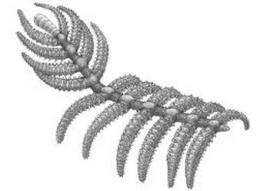'Walking cactus' rewrites arthropod odyssey

Fossils of a bizarre animal dubbed the "walking cactus" have shed light on the evolution of crabs and spiders, Chinese researchers reported in the journal Nature on Wednesday.
Specimens found in 2006 in rocks in the Jianshan area near Haikou, in southwestern China's Yunnan province, have revealed an "armoured lobopodian" that lived nearly half a billion years ago.
This was during the so-called Cambrian Explosion, an astonishing burst of biodiversity that determined the future of species which are alive today.
Measuring around six centimetres (2.4 inches) long, it comprises a central spine that resembles a skinny, soft-bodied worm, from which 10 pairs of spiny and apparently jointed limbs emerge.
The paper suggests the primitive critter is the closest-known fossil relative to modern arthropods.
Its finding boosts theories that arthropods derive from ancestors whose legs developed a tough external skeleton before their bodies did.
The species has been dubbed Diania cactiformis. "Dian" is a linguistic derivation in Chinese of Yunnan while "cactiformis" refers to cactus-like shapes.
(c) 2011 AFP

















